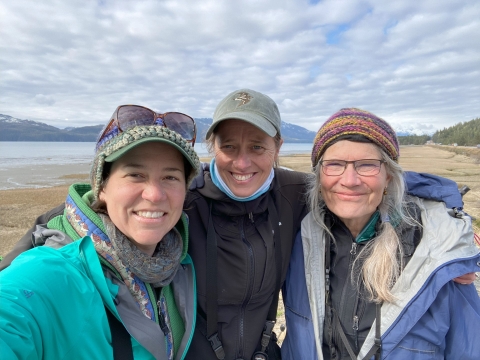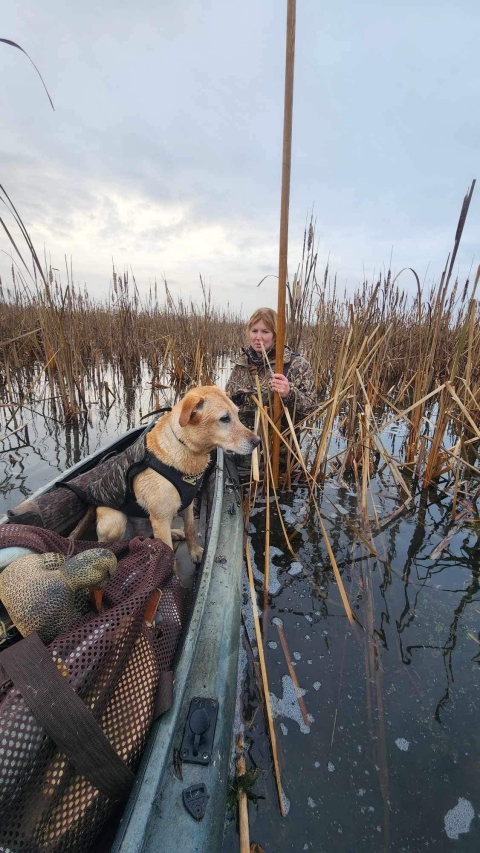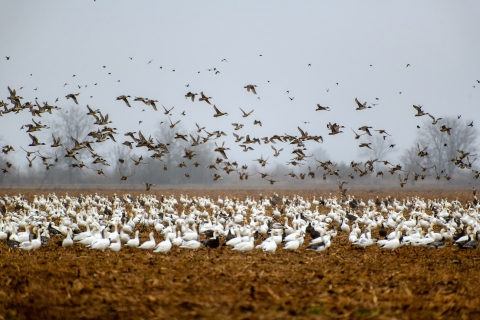For over three decades, the North American Wetlands Conservation Act (NAWCA) has supported thousands of partners all across the continent with grants for projects that promote the protection and restoration of essential wetlands and related habitats for waterfowl and other migratory birds. Central to the effectiveness of NAWCA is the collaborative efforts that bring together a broad coalition of partners, including federal, state, and local governments, non-profit organizations, and community groups from coast to coast. Among these partnerships, the contributions of women have been invaluable, offering unique perspectives, expertise, and dynamic leadership that have significantly advanced conservation efforts.
In honor of Women's History Month, the U.S. Fish and Wildlife Service's Migratory Bird Program is proud to highlight the remarkable women who have played a significant role in the success of projects funded through our North American Wetlands Conservation Act's U.S. grant programs. While the individuals featured in this story represent just a fraction of the many women contributing to these endeavors, their stories exemplify the dedication and impact of women in the field of conservation.
Their work not only fosters the health and resilience of our natural ecosystems but also inspires future generations to continue the vital work of conserving our planet's precious resources. Join us in celebrating these women and their remarkable contributions to wetlands conservation.
Wetland Warriors
Madelyn McFarland, Biologist at Ducks Unlimited Big Rivers Initiative
A conservation easement is a voluntary legal agreement between a landowner and a government agency or qualified conservation organization that restricts the type and amount of development that may take place on a property in the future. Conservation easements aim to protect habitat for birds, fish and other wildlife by limiting residential, industrial or commercial development. Contracts may prohibit alteration of the natural topography, conversion of native grassland to cropland, drainage of wetland and establishment of game farms. Easement land remains in private ownership.
Learn more about conservation easement . Photo by Dane Cramer, Regional Biologist for Ducks Unlimited.
As a biologist with the Ducks Unlimited (DU) Big Rivers Initiative, Madie McFarland plays a big role in delivering wetland restoration, enhancement, and protection projects in the Great Lakes/Atlantic Region. This involves coordinating with DU engineers, partners, and landowners to execute high-priority habitat conservation projects, especially across northern Illinois and northern Indiana.
Currently, she oversees two significant projects funded through NAWCA grants within her program area, the Rivers & Prairies of Northwest Illinois grant project and the Great Lakes Mallards grant project. The Rivers & Prairies of Northwest Illinois project aims to protect, restore, and enhance 1,668 acres of wetlands and uplands on both public and private lands across Northwestern Illinois. Madie and her team are targeting key areas within the floodplains and upland corridors of several major rivers to improve water quality, provide wildlife habitat, and offer public recreation opportunities. By the end of this grant period, DU and its partners are expected to have permanently protected over 300 acres of wetlands and grasslands, restored more than 400 acres of agricultural fields to native habitats, and enhanced over 800 acres of existing degraded habitats! Her second major project, the Great Lakes Mallards grant, focuses on protecting, restoring and enhancing nearly 1,900 acres of crucial habitat for the declining population of Great Lakes nesting birds in northeast Illinois, northern Indiana, Michigan, and Wisconsin. By aligning with the Upper Mississippi River/Great Lakes Joint Venture's breeding habitat suitability index, this initiative seeks to conserve essential wetlands and associated grassland habitats for breeding mallards.
In her role as grant administrator for both NAWCA grants, Madie is responsible for delivering all projects under The Rivers & Prairies of Northwest Illinois grant and overseeing the Illinois and Indiana projects under the Great Lakes Mallards grant. Notably, the Great Lakes Mallards NAWCA grant involves an all-women team of three DU biologists! These women are making a significant impact in conservation, both locally and globally, as the benefits of wetland restoration goes far beyond the birds. "It's really awesome to deliver a NAWCA grant that has such an expansive scope in geography, the partners involved, and the types of projects implemented with an absolutely awesome team of women. Women are impacting conservation across the world, and this passionate team of women are influencing conservation strategies on a local scale," she shares.
Further reflecting on her experience, Madie proclaims, "To me, being a woman in conservation means translating my personal experiences (both good and bad) into meaningful conservation, persevering when others doubt you, protecting the values and motivations that spurred you to go down this path, and supporting the other women in this field, especially younger women who are just starting out."
Monica Iglecia, U.S. Coordinator, Pacific Birds Habitat Joint Venture
Monica Iglecia is the first woman U.S. Coordinator for the Pacific Birds Habitat Joint Venture, where she and her team play a major role in the conservation of coastal wetlands and Western forests across the Pacific Northwest, Alaska, and Hawai'i. As the U.S. Coordinator, she supports applicants to NAWCA within these expansive regions of the joint venture by providing insights about bird values of particular projects and how their projects contribute to national and international plans, like the historic North American Waterfowl Management Plan. She works with numerous Pacific Birds staff, board members, contractors, grantees, and partners to facilitate collaborative partnerships and identify strategic direction for habitat conservation within their vast service area. Together, they are working to achieve the Pacific Birds Habitat Joint Venture's mission of conserving, protecting, and improving coastal habitats and Western forests to support migratory birds, healthy habitats and the well-being of human communities.
"My favorite moments in this role are when I get to meet partners in the field - in the places they are working to protect, improve, or restore. While it is important to identify strategies about the full life cycle needs of a migratory bird - the impact of this work happens at a local scale. From the Copper Rive Delta to Humboldt Bay, and beyond, people are working hard to ensure birds have a place to land, today, and tomorrow. Meeting the people working throughout the Pacific Birds service area energizes me about how much we can do when we are working towards common goals," Monica tells us.
As the first woman to hold the position of U.S. Coordinator for the Pacific Birds Habitat Joint Venture, Monica is pioneering a path of leadership and represents a significant step forward as we continue to embrace diversity in conservation. She is passionate about encouraging others to bring their unique leadership styles to their work, convinced that a richer diversity of voices and perspectives will lead to more innovative and enduring conservation outcomes. She expresses an encouraging vision for the future, stating, "I am hopeful that I can inspire others to bring their own leadership style to this work. The more diverse our voices and perspectives, the more innovative and durable our efforts will be," highlighting her commitment to inclusive and effective conservation practices.
Sarah Fleming, Director of Conservation Programs, Ducks Unlimited Northeast
Sarah Fleming serves as the Director of Conservation Programs for Ducks Unlimited in the Northeast, covering a vast 12-state region. In her role, Sarah has been instrumental in orchestrating significant conservation efforts, including the acquisition and restoration of a 35-acre wetland site for migratory birds, known as Dury, within the Montezuma Region of New York. This project, a key component of the North Montezuma Phase IV NAWCA grant, involved a fee-title acquisition from a willing private landowner, serving as a critical match for further NAWCA funding aimed at protecting and restoring over 1,700 acres in the region.
Sarah was actively engaged in the identification process, conducted due diligence for the fee-title acquisition, and nurtured the necessary partnerships for the project's success which ultimately culminated in the transfer of the Dury site to the Montezuma National Wildlife Refuge. This transfer ensures the long-term protection and management of the wetland for the benefit of migratory birds, a goal that aligns closely with Sarah's professional and personal passions for conservation.
"This project was one of many successful land protection projects in the Montezuma Area, where DU and USFWS cooperate to protect critical wetland resources in the region. And personally, I was able to enjoy spending quality time with my lab, hunting in the wetland before it was transferred to the USFWS. Any time spent in the marsh with my pup is a memorable experience, coupled with the knowledge that the protected wetland will continue to provide critical resources for numerous migrating waterfowl and will be protected in perpetuity. Transferring the site to a national wildlife refuge national wildlife refuge
A national wildlife refuge is typically a contiguous area of land and water managed by the U.S. Fish and Wildlife Service for the conservation and, where appropriate, restoration of fish, wildlife and plant resources and their habitats for the benefit of present and future generations of Americans.
Learn more about national wildlife refuge will ensure others can enjoy the same experiences I did, whether with your hunting partner, or simply watching the diversity of birds and other wetland dependent wildlife that use the marsh daily. I am a hunter conservationist that strives to positively advance wetland habitat conservation both professionally and personally," Sarah proudly proclaims.
Mary Anne Piacentini, President and CEO of Coastal Prairie Conservancy
As the President and CEO of the Coastal Prairie Conservancy (formerly known as the Katy Prairie Conservancy), Mary Anne leads the charge in the conservation of the coastal prairie habitat across nine counties in southeast Texas. Under her leadership, the organization has been awarded 11 North American Wetlands Conservation Act grants, amassing more than $44 million to accelerate conservation efforts in the region! This funding has enabled the Conservancy to significantly increase the pace of land acquisition—both through direct purchase and conservation easements—and ultimately, the restoration and enhancement of thousands of acres of wetlands and upland habitat.
As the guiding force behind the Coastal Prairie Conservancy, she plays a critical role in project development, from identifying priority lands for conservation to securing the necessary partnerships and resources to achieve the organization's goals. The success of these projects, which serve to bolster bird habitat and enhance community well-being, is a testament to the collaborative efforts of the Conservancy's growing team and the long-term support of NAWCA.
"A highlight for me is watching thousands of sandhill cranes darkening the sky on a winter's afternoon as they move from their feeding grounds to nearby waters where they will rest for the evening. It is heartening to know that Coastal Prairie Conservancy played a part in ensuring their food, water, and roost areas. The enhancement of critical resources for wetland and upland species, especially through funds from NAWCA, is visible across our preserved lands. Also, NAWCA support has enabled the Coastal Prairie Conservancy to help landowners and the community understand that caring about land is a key element to reducing natural resource losses and to improving the quality of life for people and wildlife," Mary Anne shares.
Reflecting on her journey as a woman working in conservation, Mary Anne describes the qualities that define her approach: "It means being resourceful, patient, persistent, open-minded, dedicated, undaunted, inspiring, adventurous, and hopeful." Through her stewardship, commitment to conservation and powerful leadership, Mary Anne continues to inspire and lead efforts to preserve the unique and vital ecosystems of southeast Texas, ensuring their benefits for future generations.
The stories of Madelyn McFarland, Monica Iglecia, Sarah Fleming, and Mary Anne Piacentini show us the undeniable impact women have on the field of conservation and the importance of diversity in leadership from coast to coast. Their stories are but a glimpse into the vast network of women whose efforts are vital to conservation across the continent. Each project and preserved acre is a testament to the collaborative spirit that drives the success of NAWCA and the broader mission of conserving our natural world for future generations. As we look to the future, their achievements inspire us to continue supporting and amplifying the voices of women in conservation, ensuring that their invaluable perspectives and contributions are recognized and celebrated.
Thank you to all our partners working hard each day to protect, restore and enhance wetland habitat for birds!
To learn more about the NAWCA grant programs, please visit North American Wetlands Conservation Act program page.













